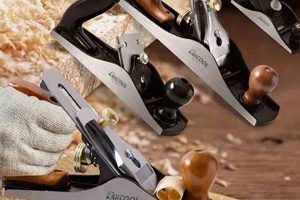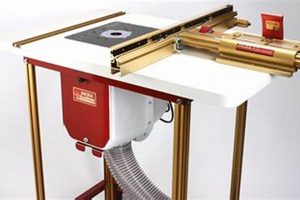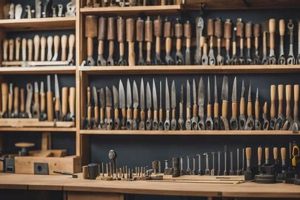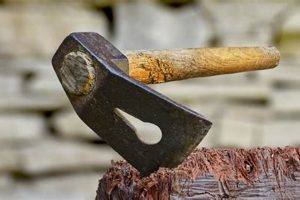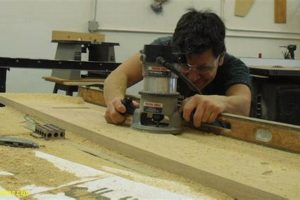The fundamental implements required to initiate projects involving the shaping and joining of wood are a carefully selected collection. This assemblage enables the creation of various wooden objects, ranging from simple boxes to intricate furniture pieces. A handsaw, a measuring tape, and a chisel, for instance, form a core set for performing basic tasks like cutting, measuring, and shaping material.
Acquiring a foundational set yields numerous advantages. It facilitates the development of skills in manipulating wood, encourages creative expression through crafting tangible items, and provides a basis for expanding capabilities with more specialized instruments later on. Historically, the ability to work with wood has been pivotal in construction, furniture making, and various other crafts, contributing significantly to societal development and artistic expression.
The subsequent sections will delve into the specific types of devices that comprise this core set, discussing their functions, selecting considerations, and proper usage techniques. This will serve as a practical guide to choosing the right equipment to effectively execute woodworking projects.
Essential Tools for Beginning Woodworking
The effective utilization of a core set of instruments significantly impacts the success of introductory projects. Proper selection, maintenance, and application techniques are crucial for safety and quality of the final product. These tips aim to provide guidance for those new to the craft.
Tip 1: Prioritize Quality Over Quantity. It is more effective to invest in fewer high-quality implements than to acquire numerous inexpensive ones. Superior materials and construction lead to enhanced durability, precision, and overall performance.
Tip 2: Master Basic Measurement. Accurate measurement forms the foundation of woodworking. A precise measuring tape or ruler, paired with careful marking techniques, minimizes errors and ensures components fit together as intended.
Tip 3: Learn Sharpening Techniques. Sharp edges are essential for clean cuts and controlled shaping. Regularly honing and sharpening blades on planes, chisels, and saws is critical for both safety and effectiveness. Utilize sharpening stones and appropriate honing guides to maintain optimal cutting performance.
Tip 4: Secure Workpieces Properly. Employing clamps or vises to firmly hold material while cutting or shaping is vital for safety and precision. Ensuring stability prevents slippage, reduces the risk of injury, and enhances the quality of the finished product.
Tip 5: Understand Grain Direction. Knowledge of wood grain orientation influences how material behaves during cutting, shaping, and fastening. Cutting against the grain can result in splintering and tear-out. Plan projects to work with the grain whenever possible.
Tip 6: Wear Appropriate Safety Gear. Personal protection is non-negotiable. Safety glasses, ear protection, and dust masks are essential to prevent injuries from flying debris, loud noise, and fine particles. A well-ventilated workspace also minimizes health risks.
Tip 7: Start with Simple Projects. Beginning with basic tasks, such as building a small box or cutting boards, allows for gaining fundamental skills before attempting more complex undertakings. Gradually increase the complexity of each task as experience is gained.
These principles, applied with care, contribute to a successful and enjoyable introduction to woodworking. Consistent practice and adherence to safety protocols will enable the creation of quality pieces and cultivate a rewarding craft.
The article will now address specific tools for commencing woodworking, followed by maintenance best practices.
1. Accuracy
Precision represents a cornerstone in the field of woodworking, directly impacting the structural integrity and aesthetic appeal of completed projects. The attainment of accuracy necessitates the utilization of appropriately calibrated measuring devices and adherence to meticulous execution techniques.
- Measurement Precision
Accurate measurement is crucial when marking, cutting, and assembling components. Tools such as steel rulers, measuring tapes, and combination squares must be used correctly. Improper measurements result in misaligned joints, dimensional inaccuracies, and ultimately, a flawed finished product. For example, a deviation of even 1/16th of an inch can create noticeable gaps or uneven surfaces in a cabinet.
- Cutting and Shaping Tolerance
Tools used for cutting and shaping wood, such as saws and chisels, must be wielded with precision to adhere to intended dimensions. Freehand cutting without proper guides or reference points can lead to inaccuracies. The use of jigs, fences, and marking gauges helps maintain consistent angles and dimensions. The ability to make accurate cuts directly influences the structural stability and aesthetic quality of joinery.
- Joinery Precision
Successful joinery relies on precisely fitted components. Whether employing dovetail, mortise and tenon, or other joinery methods, accurate measurements and cuts are vital. Even slight errors in mortise or tenon size, or dovetail angles, can compromise joint strength and appearance, requiring rework or rendering the piece unusable. Accuracy is required for a proper joint.
- Assembly Accuracy
The final stage of woodworking often involves assembling multiple components into a cohesive structure. Even with accurate individual pieces, misalignment during assembly can lead to instability, uneven surfaces, and a compromised final product. The proper use of clamps, squares, and levels during assembly ensures that the finished piece conforms to intended specifications. Clamping can also help make accurate joints.
The preceding factors demonstrate how accuracy significantly affects the outcome of woodworking projects. Investment in quality measuring tools, proficiency in their use, and careful attention to detail are prerequisites for producing high-quality, structurally sound wooden objects. Accuracy should be required for any woodworking tasks.
2. Sharpness
Sharpness is a critical attribute of woodworking implements, directly influencing the efficiency, safety, and quality of the results achieved. Its presence or absence dictates the effort required to manipulate wood, the precision of cuts, and the overall aesthetic of the finished product. Therefore, the edge quality is a paramount element in selecting essential tools for beginning woodworking.
- Cutting Efficiency
A sharp cutting edge minimizes the force necessary to sever wood fibers, thus increasing the speed and efficiency of each task. A dull blade requires excessive pressure, leading to fatigue, inaccurate cuts, and a greater risk of slippage. For example, a properly honed chisel effortlessly pares away thin shavings, whereas a dull chisel requires forceful blows and produces ragged results.
- Cleanliness of Cut
Sharp tools create clean, crisp edges and surfaces, reducing the need for post-processing such as sanding. A dull blade tears wood fibers rather than slicing them cleanly, resulting in splintering and tear-out. A sharp hand plane, for instance, leaves a smooth, polished surface, while a dull one leaves a rough, uneven texture requiring extensive sanding.
- Safety Implications
Counterintuitively, sharp tools are safer than dull ones. A sharp blade engages the material more readily, reducing the likelihood of the tool slipping and causing injury. A dull blade requires more force, increasing the risk of losing control and causing accidents. Sharpening will increase the safety of the tool.
- Tool Control and Precision
A sharp edge provides improved control over the cutting process. Woodworkers can guide the tool more accurately, achieving precise cuts and intricate shapes. A dull blade wanders and deflects, making it difficult to follow lines or execute fine details. Sharpness will increase the control and precision of the tool.
In conclusion, the maintenance of sharp cutting edges is indispensable when employing these devices. Consistent honing and sharpening techniques should be integral to the skillset of any individual engaged in woodworking. Tools not possessing adequate sharpness, irrespective of other qualities, introduce complications and compromise the integrity of the work.
3. Durability
Longevity is a critical attribute when considering foundational implements for woodworking. The capacity of equipment to withstand repeated use and potential strain directly affects its value and long-term contribution to skill development. This is particularly crucial for beginners who require reliable tools to learn and practice with.
- Material Composition and Construction
The selection of materials and manufacturing techniques employed in producing a tool dictates its ability to endure stress and resist wear. For example, hand saws featuring hardened steel blades maintain their cutting edge longer than those made from softer alloys. Similarly, chisels with impact-resistant handles withstand repeated hammering without cracking or splintering. Quality material is an essential part of durability.
- Resistance to Environmental Factors
Tools exposed to moisture, temperature fluctuations, or corrosive substances can degrade over time. Rust formation on metal components, wood rot on handles, and degradation of composite materials all impact functionality and longevity. Protective coatings, proper storage practices, and material selection designed for specific environments enhance resistance to these factors. Resistance to corrosion is crucial for durability.
- Design for Sustained Use
Ergonomic designs, balanced weight distribution, and reinforcement of stress points contribute to prolonged tool life. A well-designed hammer, for instance, reduces strain on the user’s hand and minimizes the risk of handle breakage. Tools designed to be able to be sustained for a long duration increase durability.
- Maintainability and Repairability
Tools designed for easy maintenance and repair offer extended usability. Replaceable parts, accessible mechanisms, and simple disassembly procedures allow for component restoration and prolong overall service life. For instance, a hand plane with adjustable blade depth and easily replaceable blades can be kept in optimal condition for extended periods. This makes maintainability and repairability vital for durability.
The durability of fundamental instruments serves as a sound investment. Implements constructed to endure regular use and withstand environmental stressors ensure prolonged functionality, reducing the frequency of replacement and fostering a reliable platform for skill development.
4. Safety
The integration of safety protocols is paramount when utilizing implements for woodworking, especially for novices. The inherent risks associated with sharp edges, moving machinery, and airborne debris necessitate meticulous adherence to safety guidelines and the appropriate selection and use of protective gear.
- Protective Equipment
The use of appropriate safety gear, including eye protection, hearing protection, and respiratory protection, mitigates potential hazards. Safety glasses or face shields safeguard eyes from flying debris, earplugs or earmuffs protect hearing from prolonged exposure to loud machinery, and respirators or dust masks prevent the inhalation of fine wood particles. A failure to use such equipment can result in significant injury or long-term health complications.
- Tool Condition and Maintenance
The condition of tools directly impacts operational safety. Sharp blades are safer than dull ones, as they require less force and reduce the likelihood of slippage. Regular maintenance, including sharpening, cleaning, and proper storage, ensures optimal tool performance and minimizes the risk of accidents. Neglecting tool maintenance can lead to unexpected tool failure and potential injury.
- Workplace Organization and Practices
A well-organized workspace minimizes the likelihood of trips, falls, and other accidents. Proper lighting, adequate ventilation, and clear pathways enhance visibility and reduce the accumulation of hazardous dust. Sound woodworking practices, such as securing workpieces with clamps and avoiding distractions, further contribute to a safe working environment.
- Knowledge and Training
A thorough understanding of tool operation and safety procedures is essential for preventing accidents. Instruction manuals, woodworking courses, and mentorship from experienced practitioners provide invaluable knowledge and guidance. Lack of proper training and awareness of potential hazards significantly increases the risk of injury.
These considerations underscore the significance of safety when engaging in woodworking activities. Prioritizing safety not only minimizes the risk of injury but also fosters a more enjoyable and productive woodworking experience. Ignoring the importance of safety precautions may lead to accidents and potentially irreversible harm.
5. Versatility
The attribute of adaptability constitutes a vital element in the selection of foundational implements. Tools exhibiting multifaceted utility offer cost-effectiveness and efficiency for nascent woodworkers. Limited initial investment necessitates that individual pieces of equipment perform a range of tasks effectively. This characteristic enables the execution of diverse operations with a streamlined set of resources.
An example of this characteristic is the combination square. This tool serves as a measuring device, a marking gauge, a level, and a square. Its ability to fulfill multiple functions reduces the need for separate, specialized devices. Similarly, a block plane can perform both fine trimming and chamfering tasks. Such adaptability becomes particularly beneficial when space or budgetary constraints limit the acquisition of a comprehensive tool collection. Maximizing use and reducing the overall cost by requiring more functionality out of each tool is crucial.
In essence, prioritizing multi-functional tools when assembling the basic kit allows individuals to explore various woodworking techniques without accumulating an extensive inventory of equipment. This approach promotes resourcefulness, minimizes initial financial outlay, and provides an adaptable platform for skill development. This is a huge advantage of the essential tools that beginners should take note of.
6. Maintenance
The longevity and optimal functionality of woodworking tools are inextricably linked to consistent and appropriate maintenance. Neglecting the upkeep of essential implements precipitates diminished performance, potential safety hazards, and premature equipment failure. For beginners, mastering maintenance techniques is as critical as learning basic woodworking skills, as it directly impacts the quality of their work and the cost-effectiveness of their endeavors. The connection between the condition of the essential tool and the level of maintenance performed on it is undeniable.
Consider the case of hand planes. A planes blade, when dulled from use, tears wood fibers rather than shearing them cleanly, resulting in uneven surfaces and increased effort. Regular honing and sharpening are necessary to maintain a keen edge, enabling precise cuts and a smooth finish. Similarly, saws require periodic sharpening to ensure efficient cutting and prevent binding. Wooden tool handles demand occasional oiling to prevent cracking and maintain a secure grip. Failure to address these needs not only compromises performance but also elevates the risk of accidents due to increased force requirements and reduced control. Regular maintenance is critical to performance and safety.
In summary, the commitment to diligent maintenance is essential for aspiring woodworkers. Incorporating routine cleaning, lubrication, sharpening, and adjustment practices into their workflow ensures that tools remain in peak operating condition. This ultimately contributes to enhanced precision, improved safety, and a more rewarding woodworking experience. Prioritizing maintenance safeguards the initial investment in tools and establishes a foundation for sustainable woodworking practice.
Frequently Asked Questions
The following section addresses frequently encountered queries regarding fundamental equipment used in woodworking activities. These answers aim to provide clarity and guidance on selecting, utilizing, and maintaining essential implements.
Question 1: What constitutes the absolute minimum set of tools for commencing woodworking projects?
A foundational set includes a measuring tape, a combination square, a hand saw, a chisel, a hammer, and a sharpening stone. This selection enables basic measuring, cutting, shaping, and joining operations.
Question 2: Is it preferable to acquire an entire tool set or purchase individual instruments?
For beginners, purchasing individual implements based on project requirements often proves more economical. This approach allows for prioritizing quality in essential tools and avoids acquiring unused equipment.
Question 3: How frequently should cutting edges be sharpened?
Sharpening frequency depends on usage and material type. As a general guideline, tools should be honed before each use and sharpened when the cutting edge becomes noticeably dull or inefficient.
Question 4: What safety precautions are essential during woodworking activities?
Mandatory safety measures include wearing eye protection, hearing protection, and a respirator or dust mask. Securely clamping workpieces and maintaining a clean, well-lit workspace are also crucial.
Question 5: How does one determine the appropriate type of hand saw for a specific task?
Different saw types serve specific purposes. Crosscut saws are designed for cutting against the grain, while rip saws are optimized for cutting along the grain. Smaller saws, such as dovetail saws, are suitable for fine, precise work.
Question 6: What are the best practices for storing woodworking implements?
Tools should be stored in a dry, organized environment to prevent rust and damage. Hanging tools or using toolboxes with designated compartments ensures easy access and protects cutting edges.
The preceding questions represent common concerns among individuals initiating woodworking. A clear comprehension of these aspects contributes to safer and more productive woodworking endeavors.
The subsequent segment will offer a summary of the essential points covered in this discourse and propose avenues for further exploration.
Essential Tools for Beginning Woodworking
This exposition has sought to illuminate the critical elements comprising a foundational set of woodworking implements. The selection, maintenance, and appropriate utilization of these devices underpin the successful execution of projects, foster skill development, and ensure a safe and productive environment. Attributes such as accuracy, sharpness, durability, and versatility have been examined, emphasizing their individual and collective contributions to effective woodworking practices. Moreover, the significance of adhering to stringent safety protocols has been underscored, serving as a constant reminder of the potential hazards inherent in this craft.
The acquisition of proficiency in woodworking demands not only access to suitable equipment but also a dedicated commitment to continuous learning and refinement of technique. The information presented herein serves as a starting point for individuals embarking on this journey. Continued exploration through formal instruction, mentorship, and diligent practice will further enhance understanding and mastery of this time-honored craft.


